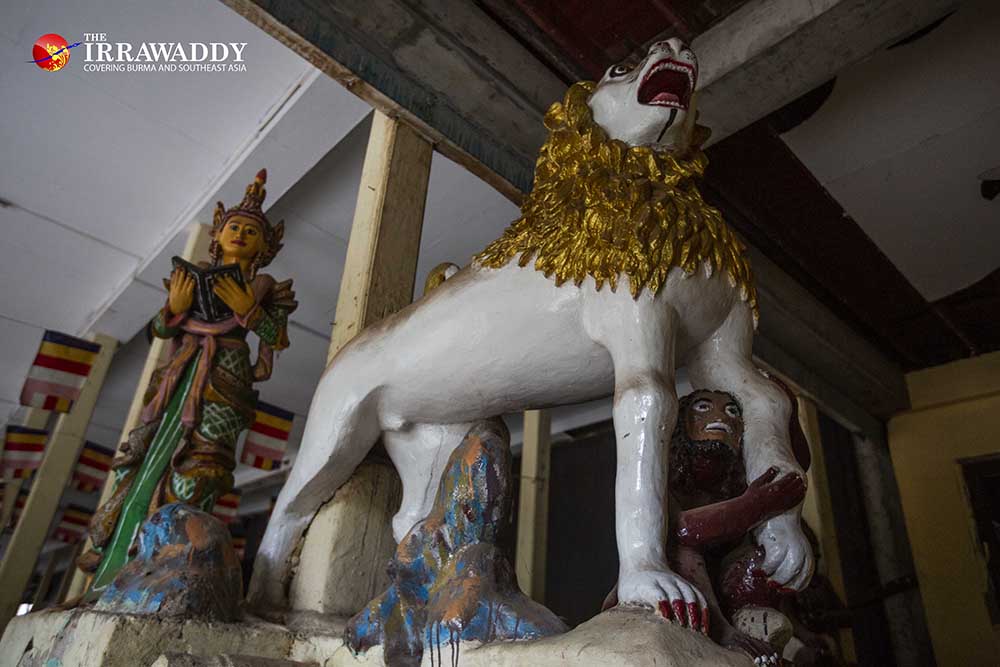Built in 1852, the 168-year-old Norman Kyaung Kyi Htaik, or Norman Monastery, in Mingalar Taung Nyunt Township, Yangon (then Rangoon) is one of the city’s oldest surviving buildings and played a key role in the educational and religious development of Myanmar.
It was built just after the Second Anglo-Burmese War, before King Mindon, the second-last king of Burma, ascended the throne. Though a number of Christian missionary schools had already been established by that time, there was not yet a government education department. The building predates even famous Christian missionary schools like St. Paul’s and St. John’s.
Constructed mainly of teak and supported by 58 timber columns, the two-story wooden building measures 100 feet (30.5 meters) by 50 feet. It was built by British engineers, according to historical records.
A boarding school, it trained teachers for Christian missionary schools. Though it was convenient for the trainees to live at the school, it was located far from downtown, and wild animals posed a constant danger.
At the time, Yangon remained largely a forest and residential wards and roads were still being built. Wild animals, including tigers, roamed the city. Pazundaung, where the Norman Monastery is located, was home to tigers and today’s U Wisara Road near Shwedagon Pagoda was then called Tiger Alley.

As a result, the school’s principal and trainees asked authorities to relocate the school. The current abbot of Norman Monastery, U Tezita, said the school moved partly because of the smell of burning corpses that emanated from a nearby cemetery. The abbot said he heard that the school moved to Insein.
After King Thibaw was sent into exile in 1885, wealthy Burmese merchant Sir Pho Tha bought the building at a government auction for 20,000 rupees and donated it to Ashin Pyinnyar from Monywa in Upper Myanmar on June 17, 1888. The monk converted the building into a monastery and became its first presiding monk. Ten monks have been in charge of the monastery since his tenure.
The monastery then expanded thanks to donations from knighted Burmese merchant U Pho Tha and various other wealthy donors. Another two-story building that measures 100 by 25 feet was built in 1889 to link with the main building. An additional structure was built on a 2-acre [0.8-hectare]-wide compound in 1917.
The building has architectural significance, featuring traditional Myanmar arts and crafts. The decorations were designed by architect Saya Khin Gyi of Mandalay, the last royal capital of Myanmar, and carried to Yangon by train.
Throughout the colonial period, the monastery played an important role in preserving Buddhism, instructing monks in Buddha’s teachings and organizing religious examinations.
The building was a landmark, brightly lit with kerosene lamps and, after the city was electrified, with electric bulbs. Inside, the monastery was also fully furnished. On one side that was close to residential buildings, it was covered with tall corrugated iron sheets to protect it from fire.
During World War II, British troops forced Yangon residents to leave the town and set many houses on fire. The troops spared the monastery as the abbot promised that he was moving out shortly. Every day, sparks from burning houses in the surrounding area rained down on the monastery’s roofs, forcing monks and monastic students to brush them off. During the Japanese invasion, they also defended the monastery against attackers and looters.
The building continued to serve as a monastery after independence, and celebrated its centenary in 1988—the year that marked the height of the pro-democracy uprising in Myanmar.
The monastery, which is now the abode of over 30 monks, survives in all its glory with teak stairs that date back to the time of the Christian school, and featuring arabesque-style ornamentation, a steeple and sculptures that were added when the building was turned into a monastery.
It has been 168 years since the building was first established as a Christian school, and it has been a monastery for 132 years. Even the monastery’s thick walls are 114 years old.
Despite its long history and architectural importance, the monastery has not been properly conserved over the years. It is not yet on the government’s list of heritage buildings and has not received official protection.
Some timber columns and other parts of the monastery are in ruins, and the monastery is short on maintenance funds, said abbot U Tezita. Some of its upper structures have had to be removed due to strong winds, and some timber columns have been replaced with concrete pillars, he said.
Yangon Heritage Trust program officer U Thurein said the group undertook site assessments and offered basic guidelines and advice to the abbot a few years ago on how to maintain the building. The group said it plans to eventually install a blue plaque at the building to recognize its historic and architectural significance, but only after more historically significant buildings have been designated.
Translated from Burmese by Thet Ko Ko

















